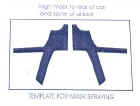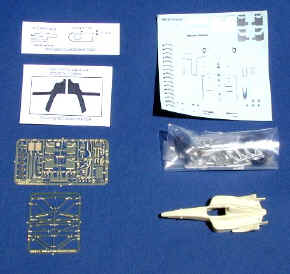|
||||||||||
|
New models of current Formula 1 cars, that aren't Ferraris, have been very limited. Tameo and Provence Moulage released the Toyota TF-102 and Renault R202 respectively, and now Crescent Models have entered the 1/43 arena with the release of two new Williams models. Released at the same time, kit CM01 represents the FW22 of Button and Schumacher during the 2000 season, and kit CM02 is the 2001 Monza winning FW23B of Juan Pablo Montoya. Crescent Models is a new manufacturer and their first releases are outstanding. Colin Fraser sculpted the masters, and anybody familiar with Marsh Models will be familiar with his work. In fact, the general feel of the kits is very Marsh like, which is a good thing, because these kits are of a very high quality. My review will mainly concentrate on the FW23B, as it is slightly more complicated, but many of my comments apply to both kits.
The kit The body is a very crisp casting that has the underside of the nose molded in, saving the builder the unpleasant task of filling this awkward seam. The body's overall shape appears to be very accurate and matches photographs well. I do have a little concern about the head-on shape of the airbox opening. Photographs of the car reveal a wider and less angular opening. However, this is a minor point and once the body is painted, the TV camera added, and the opening filled in with a matt black paint, the angular shape may not be that noticeable. The rear turning vanes and wheel deflectors are integrally cast into the body. Crescent could have provided these as photo-etched parts, but on the real car they are sculpted into the body and not add on parts. Photo-etched parts would have looked tacked on and would not have captured the look accurately. The wheel deflector endplates would benefit from a light sanding to thin down their thickness, as would the turning vanes. The small winglets on the body just above the wheel deflectors are provided as white metal castings. Because of their compound curves, these too would not have been practical in photo-etch. Because Crescent has done the majority of the work on the body for the builder, preparation for painting should be quick and easy.
The undertray is very cleanly cast in white metal and will give the completed model a satisfying weight. Dry fitting the undertray to the resin body reveals an excellent fit. The front and rear suspension pieces are nicely etched in 15 thousands brass even though the engraving on the fret says it is nickel silver. Added to these parts are the white metal brake ducts and etched turning vanes. The brake discs and wheel hubs are nicely turned in brass. The brake calipers follow Tameo's current trend of being cleanly cast white metal parts. The wheels are made up of two pieces with a beautifully turned aluminum rim and an etched center insert. The tires have small feed tags that are easily cleaned up and their profile look very convincing.
Painting of the rear wing should be pretty straightforward, as the white sections are provided as a decal. Finally, the bargeboards are supplied in etched brass. They are a somewhat complicated double bargeboard made up of five parts each. Once the larger board is curved, the smaller curved board is attached to the main bargeboard. It would pay to go slowly here. A nice touch is the inclusion of a photograph of the assembly on the real car on the instructions. It greatly clarifies the relationship of the parts.
The instructions provide clearly written assembly notes, an exploded assembly diagram with a color chip for the blue, and a color sheet with five photos of the assembled model. The color sheet is provided as a painting and decal guide. It is highly recommended that the instructions be carefully read before assembly begins to avoid confusion about some of the smaller assemblies. The decal sheet is very well printed and in register. The white portions of the decals appear to be very dense and will eliminate any bleed through. The smaller decals are all readable, and almost as crisp as would be found on a Cartograph sheet. The only criticism I would level at the decal sheet would be that the carbon fiber decals are just not convincing. They would be better replaced with an after market decal. A spare sheet of decals would also have been appreciated, because invariably, screw ups in decaling do occur.
The separation between the white and blue is provided as a silver decal. I have read elsewhere that Tamiya Telefonica Blue is a perfect match for the blue on the Williams, but I have to disagree. The instruction sheet recommends Dupont Pearl Blue PO824, and based on the color chip provided, it appears to be much darker than Teleonica Blue. Tamiya has recently release a pearl blue paint for their forthcoming 1/20Williams FW24 kit that appears to be an exact match. If that paint hasn't shown up in your local hobby shop yet, Tamiya TS-53 Deep Metallic Blue also looks to be a very close match. Summing up With the exception of the painting recommendations above, many of my comments also apply to Crescent's FW22 kit. I have included a photograph the main parts included in the FW22 kit for comparison. I can not express well enough how happy I am that Crescent Models has provided us with high quality kits of recent Williams cars. The quality of these kits is top notch and easily equal to the quality we've come to expect from Tameo. Builders of 1/43 scale Formula 1 models need to fully support Crescent Models' effort so that we can see more new releases in the future. I would love to see a new Jaguar or Sauber, because they are great looking cars and you can only build so many Ferraris. I want to thank Crescent for an outstanding first effort and for supplying the review model.
|











